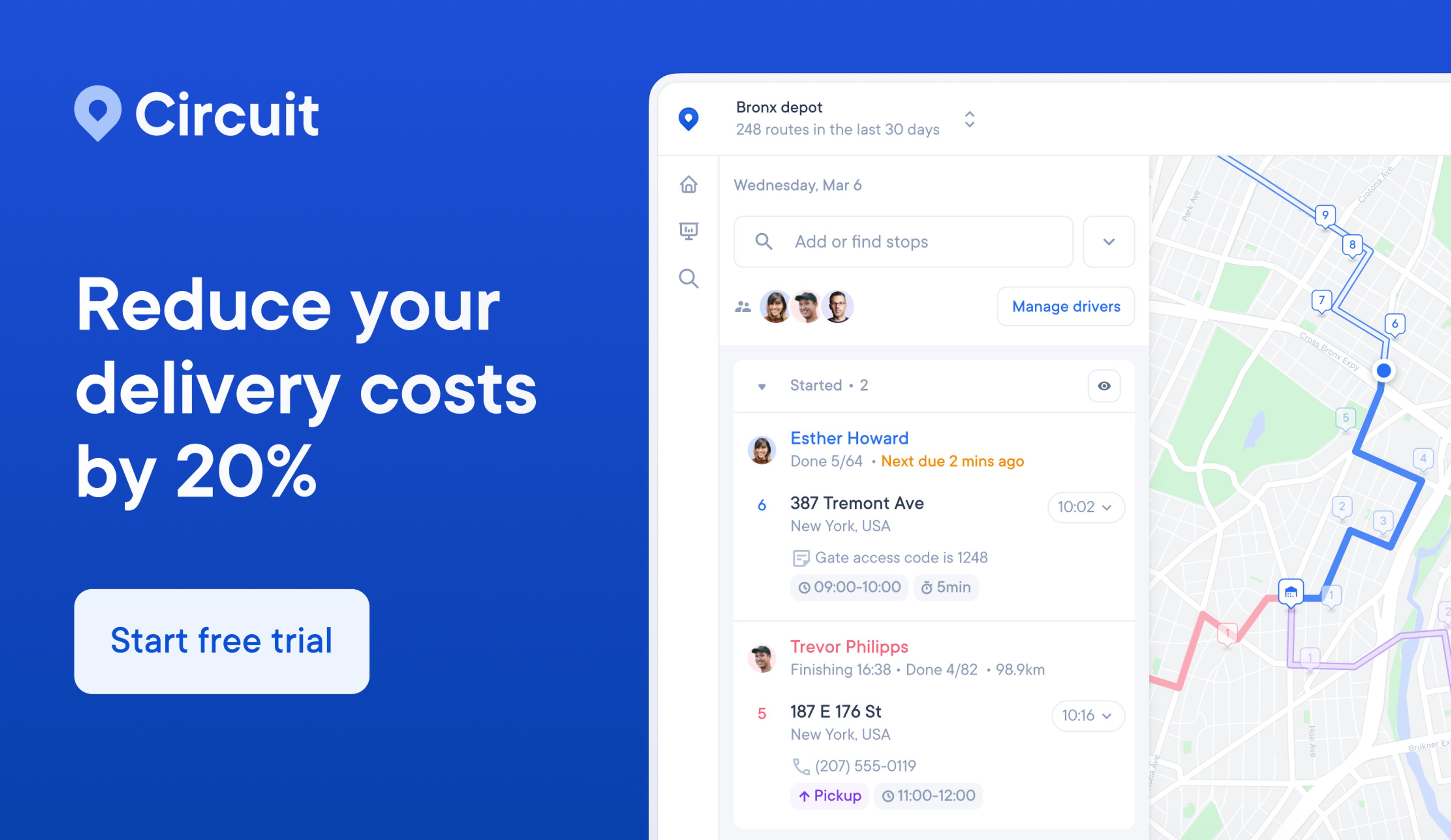7 Tips for Tracking Inventory in 2023

Improving inbound and outbound deliveries is essential to successful inventory and warehouse management. Circuit for Teams can help you manage drivers and deliveries.
If you have a retail or eCommerce business, you’re probably familiar with the challenge of managing the demand and supply of goods.
It can be difficult to decide how much or how little of a product you should order to avoid a stockout, backorders, or hundreds of unsold items.
Too much stock on hand can put pressure on your warehouse systems and hurt profitability.
At the same time, stockouts are frustrating for customers and can lead to lost sales and revenue.
Accurate inventory tracking is key to managing stock.
For example, if you sell a product that expires (like cheese), you must account for expiration dates in your inventory tracking methods.
An inventory management system can help you improve cash flow, save money, and keep customers happy.
However, inventory tracking can be time-consuming — especially if you offer a large number of products or have many sales channels, purchase orders, and sales orders to get through.
Luckily, I’ve got some great tips to help you approach your inventory tracking system and supply chain management.

Create priority groups
Start by grouping your inventory based on priority.
This can help you identify products you need more of, items that are important for your business, and goods that move quickly.
Creating priority groups also helps with capacity planning.
Capacity planning involves making sure your business can meet customer demands.
Creating a priority group can help because it allows you to identify which customers need products more urgently and which ones can wait.
One way to do this is by categorizing inventory items into three groups. For example:
- Group 1 might consist of expensive stock-keeping units (SKUs) that take time to sell. You may need fewer quantities of these products.
- Group 2 might have moderately priced products. These items typically sell quicker than Group 1 but not as fast as Group 3.
- Group 3 might include lower-cost items with a quick turnover. You should keep a larger inventory of these.
Update your tracking system
If you own a small business or startup with few products, you may still be using Excel spreadsheets or a good ol’ pen and paper to keep tabs on your inventory.
While these are certainly low-cost methods, they may prove costly in the long run.
Manual inventory tracking can be time-consuming and prone to human error.
Picture this: You’re updating your inventory data at the end of a long day.
You’re tired and accidentally write one less zero while ordering Christmas wreaths for the coming festive season.
By the time you realize your mistake, it’s already too late and you’re staring at an imminent stockout.
Automated inventory tracking software — like Zoho, On Shelf, and Inventory Now — can help you avoid those situations by creating daily or weekly inventory reports that help you determine when specific products have low stock.
Some have advanced features like cloud-based, real-time inventory tracking across locations.
Many inventory system management software programs have mobile apps, so you can track your inventory from your mobile device while on the go.
Manage supplier relationships
Having reliable vendors is essential for any business.
If you have suppliers who deliver the right products and raw materials on time, never let them go!
It’s worth investing time and effort into building lasting relationships with vendors and wholesalers.
Simple things like paying bills on time and treating suppliers with respect can go a long way.
Remember to communicate regularly and clearly with your vendors.
Tell them in advance if you’re having a big anniversary sale so they can help with replenishing stock in time.
However, if your vendors are often late or make mistakes while delivering products, consider taking action.
Try to understand and solve the root cause of the problem. If the issue persists, consider finding a new supplier.
Establish regular audits
While running a product-based business, you may need to store goods in several warehouses or distribution centers.
It’s important to regularly count your products and make sure the numbers match the inventory records.
Besides this, you can also track your inventory turnover ratio to see how fast things are moving in and out.
If certain months seem to differ from other months by a large number, that’s a cause for concern.
A mismatch in the numbers can cause problems in future purchasing decisions and order fulfillment.
If your inventory turnover ratio tells you you’re moving goods faster than you actually are (or vice versa), you may end up with excess or less stock.
(Check out our post on calculating inventory shrinkage.)
You should also investigate the cause of the error and find ways to prevent it from happening again.
For example, if you realize it was an accounting mistake, you know you need to be more careful with your accounting practices.
Depending on your business needs, you might do stock or inventory audits daily, weekly, or monthly.
Analyze specific sales
As a business owner, you need to know how much revenue you earn daily and from which products.
Tracking your daily sales can help you get deeper insights, like which day of the week you sell more items.
Is the demand for certain products seasonal?
Are two products usually brought together?
This data can be valuable for understanding sales patterns and behaviors, helping you manage your inventory.
Create a contingency plan
You may spend days studying your demand and supply to create the “perfect” inventory forecast.
But remember, sometimes things just might be out of your control.
Businesses across the globe faced massive disruptions due to the COVID-19 pandemic.
Import-export operations were hit and supply chains were backed up by months.
In fact, 39 percent of supply chain executives said inventory management was the aspect of their supply chain most impacted by the pandemic.
So, what can you do to prepare for unexpected circumstances?
We recommend creating a contingency plan.
Simply put, a contingency plan is a “Plan B.”
It’s a strategy to help you manage risks in case of a future event or situation that could negatively impact your business.
Contingency planning has three main steps:
- Assessment
- Planning
- Communication
In step one, you’ll consider problems that could potentially pop up in your business.
Make a list of “what-ifs” and the potential impact they could have on your organization.
Here are some possible scenarios to include:
- Your warehouse runs out of space
- You buy too much of a product and demand suddenly falls, resulting in a significant surplus
- You order too little of a product and demand skyrockets, resulting in a massive stockout
- Your vendor informs you they can’t meet the delivery deadline for new stock a few days before a promotional event
- Power outages prevent you from accessing your inventory management software
Step two involves planning how you’d respond to any of those situations.
Be very specific. Include details like the timeline for resolving problems and different team members’ roles.
At this stage, you can also include preventive solutions to help reduce the risk of a damaging event to your business.
Let’s use the first possible scenario as an example: Your warehouse runs out of space.
To prepare for that situation, you might increase your warehousing space by adding more vertical storage, decreasing aisle widths, and introducing a barcode scanner system with radio frequency identification (RFID) integrations.
RFID technology uses radio waves to identify and track object tags.
Step three is to communicate the contingency plan to all stakeholders.
Your team should be clear on exactly how to respond to any potential situations and jump into action if they happen.
Use data to create accurate forecasts
Forecasting is an important step in inventory tracking.
Many inventory automation tools allow you to create reports and analyze sales.
With this information in hand, you can forecast future demand and order stock accordingly.
Accurate forecasting helps you have enough stock to fulfill orders without tying up cash and resources in inventory that’s not immediately needed.
Although forecasting is a scientific process, past data isn’t always enough to predict future demand.
Pay attention to recent micro-trends that affect sales and prices for only a few weeks.
Don’t forget to consider seasonal changes in demand.
When inventory forecasting, you should also look at your lead time demand.
You can figure this out by multiplying your average lead time in days by your average daily sales.
Understanding how long it takes for order fulfillment can help you predict how much stock you need at a given time.

What metrics are typically measured when inventory tracking?
Inventory tracking covers several parts of the fulfillment process. Key metrics include:
- Stock levels: Inventory tracking — whether automated or manual — looks at how much of each item you have at a given time. These inventory counts are crucial, as they let you know if you have enough stock to continue fulfilling customer orders.
- Stock location: As your stock passes through different stages of the supply chain, it’s constantly moving. It’s sorted, categorized, and shipped to its next location. Given the continuous movement of products, it’s important to be able to track where an item is at any time.
- Carrying costs: Carrying costs are how much you spend on storing, holding, and owning your stock. It includes labor, rent, and security. Analyzing carrying costs can help determine how long you can afford to store a particular product. If an item is slow-moving, it will have a high carrying cost, and it may not be worth it to continue holding it.
- Inventory valuation: Your inventory is an important asset for your business. Calculating inventory value helps you determine your cost of goods sold (COGS) and profitability. Your COGS is the direct cost of making or buying the product. An accurate inventory valuation is important for your financial statements and for figuring out inventory turnover.
- Inventory accuracy: Inventory accuracy measures the ratio between the quantity of inventory you’re tracking and the amount physically present with you. Differences between these two values can be caused by theft, shortages, or damage. Inventory accuracy can help you identify discrepancies. How does this translate into your daily workflow? If you have accurate inventory, employees can find the items they need labeled correctly and in the recorded quantity.
Shipping inventory yourself? Circuit for Teams simplifies the process
Here’s the bottom line: Investing in effective inventory management solutions is important.
Tracking your inventory as it moves through different stages of the supply chain is essential.
This can help you track theft and identify where there’s room for your inventory to move faster.
Moving inventory quicker can also help you boost customer satisfaction since it means your customers will get their products faster.
Last-mile delivery is one of the steps involved in tracking inventory.
And this is where you could consider using Circuit for Teams.
Circuit for Teams takes the stress out of managing delivery routes by optimizing stops so drivers can complete deliveries quickly and efficiently — saving you time and transportation costs.
With real-time driver tracking, you can also know exactly where your deliveries are and when they arrive.
This can help you with inventory tracking and logistics planning.
You can also make customers happy by sending out automated notifications to update them on the expected time of delivery.






